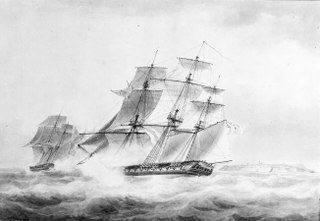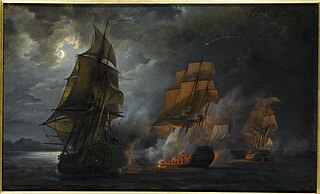Related Research Articles

HMS Minerva was a 38-gun fifth-rate Royal Navy frigate. The first of four Minerva-class frigates, she was launched on 3 June 1780, and commissioned soon thereafter. In 1798 she was renamed Pallas and employed as a troopship. She was broken up in 1803.

HMS Lively was a 20-gun post ship of the Royal Navy, launched in 1756. During the Seven Years' War she captured several vessels, most notably the French corvette Valeur in 1760. She then served during the American Revolutionary War, where she helped initiate the Battle of Bunker Hill. The French captured her in 1778, but the British recaptured her in 1781. She was sold in 1784.

Jean-Marthe-Adrien L'Hermite was a French sea captain and rear admiral, notable for his involvement in the Glorious First of June and his expedition into the Atlantic in 1805.
Caton was a 64-gun ship of the line of the French Navy, launched in 1777.
Solitaire was a 64-gun ship of the line of the French Navy, built by Antoine Groignard and launched in 1774, lead ship of her class. She was captured by the Royal Navy on 6 December 1782, and commissioned as the third rate HMS Solitaire. She was sold out of the Navy in 1790.

HMS Phoenix was a 36-gun Perseverance-class fifth-rate frigate of the Royal Navy. The shipbuilder George Parsons built her at Bursledon and launched her on 15 July 1783. She served in the French Revolutionary and Napoleonic Wars and was instrumental in the events leading up to the battle of Trafalgar. Phoenix was involved in several single-ship actions, the most notable occurring on 10 August 1805 when she captured the French frigate Didon, which was more heavily armed than her. She was wrecked, without loss of life, off Smyrna in 1816.

Surveillante was an Iphigénie-class 32-gun frigate of the French Navy. She took part in the Naval operations in the American Revolutionary War, where she became famous for her battle with HMS Quebec; in 1783, she brought the news that the war was over to America. She later took part in the French Revolutionary Wars, and was eventually scuttled during the Expédition d'Irlande after sustaining severe damage in a storm. The wreck was found in 1979 and is now a memorial.

Résolue was an Iphigénie-class 32-gun frigate of the French Navy. The British captured her twice, once in November 1791 during peacetime, and again in 1798. The Royal Navy hulked her in 1799 and she was broken up in 1811.

Iphigénie was a 32-gun Iphigénie-class frigate of the French Navy, and the lead ship of her class. She was briefly in British hands after the Anglo-Spanish capture of Toulon in August 1793 but the French recaptured her December. The Spanish captured her in 1795 and her subsequent fate is unknown.
HMS Swift has been the name of numerous ships of the Royal Navy:
The action of 6 December 1782 was an naval encounter primarily fought between HMS Ruby and the French ship Solitaire off the coast of Martinique. Ruby easily defeated Solitaire.

The French frigate Aigle was launched in 1780 as a privateer. The French Navy purchased her in 1782, but the British captured her that same year and took her into the Royal Navy as the 38-gun fifth rate HMS Aigle. During the French Revolutionary Wars she served primarily in the Mediterranean, where she was wrecked in 1798.
The action of 5 September 1782 took place during the American War of Independence between two French Navy frigates, Aigle and Gloire, and a lone British 74-gun ship of the line HMS Hector. In a two-day battle, the two frigates severely damaged Hector and only failed to capture her when a British squadron appeared on the horizon. The French withdrew, but Hector foundered a few days later after the 1782 Central Atlantic hurricane.
The action of 18 June 1799 was a naval engagement of the French Revolutionary Wars fought off Toulon in the wake of the Mediterranean campaign of 1798. A frigate squadron under Rear-admiral Perrée, returning to Toulon from Syria, met a 30-ship British fleet under Lord Keith. Three ships of the line and two frigates detached from the British squadron, and a 28-hour running battle ensued. When the British ships overhauled them, the French frigates and brigs had no choice but to surrender, given their opponents' overwhelming strength.

The French brig Suffisante was launched in 1793 for the French Navy. In 1795 the Royal Navy captured her and took her into service under her existing name. HMS Suffisante captured seven privateers during her career, as well as recapturing some British merchantmen and capturing a number of prizes, some of them valuable. She was lost in December 1803 when she grounded in poor weather in Cork harbour.

Brillant was a 64-gun Solitaire-class ship of the line of the French Navy.
HMS Fortune was a British 14-gun sloop launched in 1778 that the French captured in April 1780. She then served with the French navy under the same name.

Amazone was a 32-gun Iphigénie-class frigate of the French Navy. She was the second ship of the French Navy to receive a copper sheathing in 1778. She served in the War of American Independence under Captain Lapérouse, and later in the French Revolutionary Wars.

Triton was a 64-gun ship of the line of the French Navy designed by François Coulomb the Younger. She took part in the Seven Years' War and in the War of American Independence.
HMS Requin was the French Navy cutter Requin, launched at Boulogne in 1794. HMS Thalia captured Requin in 1795. Requin captured one small French privateer and participated in the capture of Suriname before wrecking in 1801.
References
- Arnell, J.C., and K. S. Mackenzie (1980) Atlantic mails: a history of the mail service between Great Britain and Canada to 1889. (National Postal Museum (Canada)). ISBN 978-0919882072
- Austen, Harold Chomley Mansfield (1935) Sea Fights and Corsairs of the Indian Ocean: Being the Naval History of Mauritius from 1715 to 1810. (Port Louis, Mauritius:R.W. Brooks).
- Demerliac, Alain (1996) La Marine De Louis XVI: Nomenclature Des Navires Français De 1774 À 1792. (Nice: Éditions OMEGA). ISBN 2-906381-23-3
- Guérin, Léon (1857). Histoire maritime de France (in French). Vol. 5. Dufour et Mulat.
- Journals of the House of Commons (1803), Vol. 42. (Great Britain. Parliament. House of Commons).
- Troude, Onésime-Joachim (1867). Batailles navales de la France. Challamel ainé.
- Winfield, Rif & Stephen S Roberts (2015) French Warships in the Age of Sail 1786 - 1861: Design Construction, Careers and Fates. (Seaforth Publishing). ISBN 9781848322042